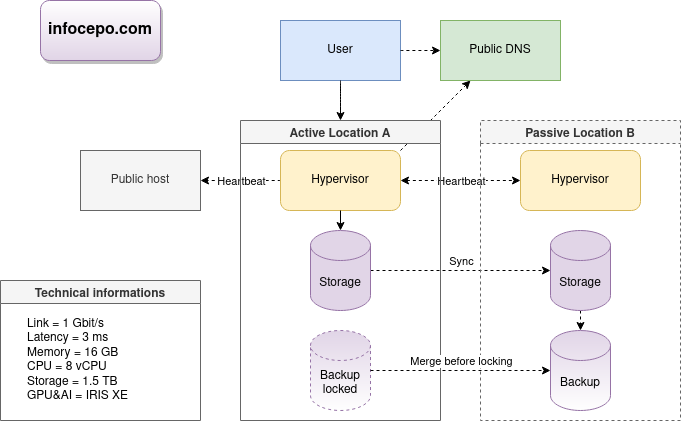Main Page: Difference between revisions
Jump to navigation
Jump to search
| Line 12: | Line 12: | ||
*Each time you need dynamic computing power think about load balancing or native service from the providers (caution about providers services!) | *Each time you need dynamic computing power think about load balancing or native service from the providers (caution about providers services!) | ||
*... | *... | ||
*Try to use | *Try to use open source STACKs as much as possible | ||
*... | *... | ||
*Use cache for your databases like MEMCACHED | *Use cache for your databases like MEMCACHED | ||
Revision as of 11:18, 10 March 2022
NEWS
How to improve your application in the cloud
- Formalize your infrastructure as much as possible for more flexibility, low complexity and less technology lock.
- Use a name server able to handle the position of your customers like GDNS
- Use a minimal instance and use a network balancer like LVS. Monitor the global load of your instances and add/stop dynamically as needed
- Or, many providers have dynamic computing services. Compare the prices. But take care about the technology lock.
- Use a very efficient TLS decoder like the decoder non blocking from ATS
- Use very fast http cache like VARNISH
- Use a big cache for big files like ATS
- ...
- Each time you need dynamic computing power think about load balancing or native service from the providers (caution about providers services!)
- ...
- Try to use open source STACKs as much as possible
- ...
- Use cache for your databases like MEMCACHED
Sample of my process of migration CLOUD
- 1.5 days: infra audit (82 clustered services) (audit own tool)
- 1.5 days: physical and virtual target CLOUD architecture diagram
- 1.5 days: construction of 2 CLOUD (physics)
- 1.5 days: installation of the 2 CLOUDs
- 1.5 days: CLOUD automation study
- 1.5 days: 6 templates (2 CLOUD, 2 OS, 8 environments, 2 versions)
- 1 day: migration diagram
- 1.5 days: 138 lines of industrialization code for migration (migration own code)
- 1.5 days: process stabilization
- 1.5 days: CLOUD benchmark vs old INFRA
- .5 days: calibration of unavailability time per unit migration
- 5 minutes (effective load): 82 VM (env, os, application_code, 2 IP)
Total = 15 man-days
Recent attacks ;)
attack map : Virtual position from people trying to attack my CLOUD.
LAB CLOUD
I want to share my LAB project.

CLOUD vs HW
| Function | KUBERNETES | OPENSTACK | AWS | Bare-metal | HPC | CRM | OVIRT |
| DEPLOY | HELM/ANSIBLE/SH | HELM/ANSIBLE/SH | TERRAFORM/CLOUDFOUNDATION | ANSIBLE/SH | XCAT/CLUSH | ANSIBLE/SH | ANSIBLE/PYTHON/SH |
| BOOTSTRAP | API/CLI | PXE/API/CLI | API/CLI | PXE/IPMI | PXE/IPMI | PXE/IPMI | PXE/API |
| Router | API/CLI (kube-router) | API/CLI (router/subnet) | API/CLI (Route table/subnet) | LINUX/OVS/external | XCAT | LINUX/external | API |
| Firewall | INGRESS/EGRESS/ISTIO | Security groups | Security group | LINUX | LINUX | LINUX | API |
| Vlan | DANM | API/CLI (VPC) | API/CLI (VPC) | OVS/LINUX/external | XCAT/external | LINUX/external | API |
| Name server | coredns | dns-nameserver | Amazon Route 53 | GDNS | XCAT | LINUX/external | API/external |
| Load balancer | kube-proxy/LVS(IPVS) | LVS | Network Load Balancer | LVS | SLURM | Ldirectord | |
| Storage | many | SWIFT/CINDER/NOVA | S3/EFS/FSX/EBS | OPENSTACK SWIFT/XFS/EXT4/RAID10 | GPFS | SAN | GLUSTERFS/SAN |
